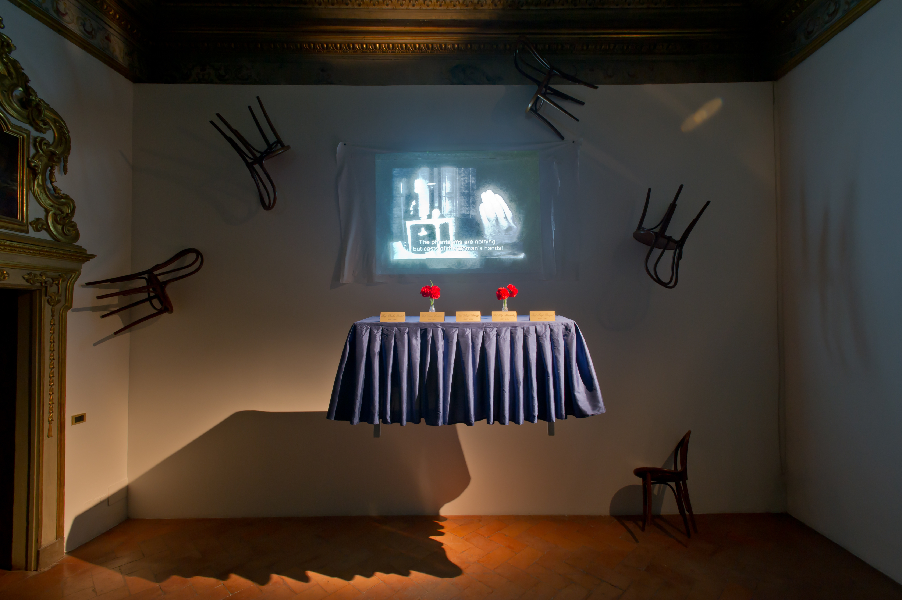Field Trip: The Yellow Side Of Sociality At BOZAR, Brussels

Can colour provoke thought about culture? Sinead Nunes visits an exhibition using yellow as a catalyst to consider cultural identity through the challenges and opportunities of migration…
For this exhibition at BOZAR, Brussels’ Centre for Fine Arts, curator Nicola Setari has gathered together contemporary artists from different regions and generations in Italy who have migrated to other European countries, and whose socially and poetically engaged work reflects the many tones and meanings of ‘yellow’ in Italian culture.
So what does ‘yellow sociality’ mean? The exhibition explores the concept of community so distinctly nurtured in Italian culture, and the colour yellow, which connotes both positive and negative associations: summer, happiness, optimism, cowardice and jealousy. According to Setari, as a ‘shade of sociality’, yellow captures the complexity of Italian culture and identity whilst also communicating the country’s unique tradition of placing art at the centre of social intercourse; the country has “a special kind of social sensitivity and intelligence that we could define as ‘yellow’”.
As strange as this sounds, as a concept it does work; the theme is explored both literally and more loosely in all works, and many artists invite visitors to interact. As you enter the gallery, Michelangelo Pistoletto’s The Love Difference (2002) encourages you to explore the diversity of Mediterranean society: a large mirrored table in the shape of the sunny subcontinent is a plea for a cultural exchange, whilst a collection of chairs from various eras surrounding the table symbolise the cultures of the different countries which border the sea there. If only to appreciate the artistry of these carved artefacts, the sculpture is definitely worth spending time with.
Nearby is Micol Assaël’s immersive Gli Sconosciuti. This work consists of an assemblage of paper and beeswax sculptures within a bright yellow room, and an audio track which follows visitors throughout various points of the museum. The almost white-noise sound of the bees whispering through the gallery’s speaker system seems intentionally intrusive, creating a claustrophobic sense of voyeurism as you walk around the space.
Another interactive piece, Rosas-Movie Set by Marinella Senatore, is a studio space open to the public and to local artists and filmmakers, offering an opportunity to create new work and a platform for exchange between artist and audience. Simultaneously an environmental installation and a public room for hire, the space is flooded with yellow light, with a mirror, ballet bar, retro monitors and large spotlights, making Senatore’s work a space of possibilities, where other Europeans can collaborate with an Italian artist.
Heading deeper into this as yet linear warren, the visitor is confronted with a circular atrium, surrounded by walkway-like gallery rooms. Rosa Barba’s stunning installation The Indifferent Back of a View Rather Than Its Face (2010), is a lightweight tapestry in the guise of a suspended page whose letters are laser cut into the fabric. The text is a fragment of the autobiography of Vladimir Nabokov, and letters and words made of light filter through the fabric in a dialogue between presence and disappearance, casting shadows across the wall behind. The text and its double, the ambiguity of the word and of the reality in this beautiful installation bring into question what the author truly intended his memoir to mean, and how like a colour, its symbolism can be interpreted in so many ways.
Finally my favourite: in a darkened room, a table and four chairs float above the ground, whilst a grainy black and white film fills the space with scratchy, disembodied voices. Chiara Fumai’s La donna delinquente (The Criminal Woman (2011-13)) is based on the misogynistic-positivist book by Cesare Lombroso, published in 1893, when the criminologist was following the séances of the medium Eusapia Palladino, in Italy and throughout Europe. Artist Fumai invites us to attend the ghostly conference of Lombroso, a group of positivist scientists and a well-known journalist Luigi Barzini. Yellow is also the universal colour of warning, and these voices travel through time to discuss spirits, preconceptions and credulity, allowing us to explore another, darker dimension of Italian culture, wracked with falsehoods and trickery.
The scope of the exhibition is broad, and also includes work by Nico Angiuli, Davide Bertocchi, Rossella Biscotti, Christian Frosi, Renato Leotta, Diego Perrone, Cesare Pietroiusti, Vettor Pisani, Ettore Spalletti, Luca Vitone and Franz West. The Yellow Side of Sociality succeeds in making the audience consider the connotations of this colour and how it relates to Italian culture throughout modern history, as well as shining a spotlight on a new generation of Italian-born artistic talent.
Sinead Nunes
Visit BOZAR Centre for Fine Arts, Rue Ravenstein 23, 1000 Bruxelles; for info and tickets 02 507 82 00; map here
The Yellow Side of Sociality continues at BOZAR, Brussels, until 25 January 2015. Open Tuesday-Sunday 10am-6pm, Thursdays 10am-9pm, free entry





